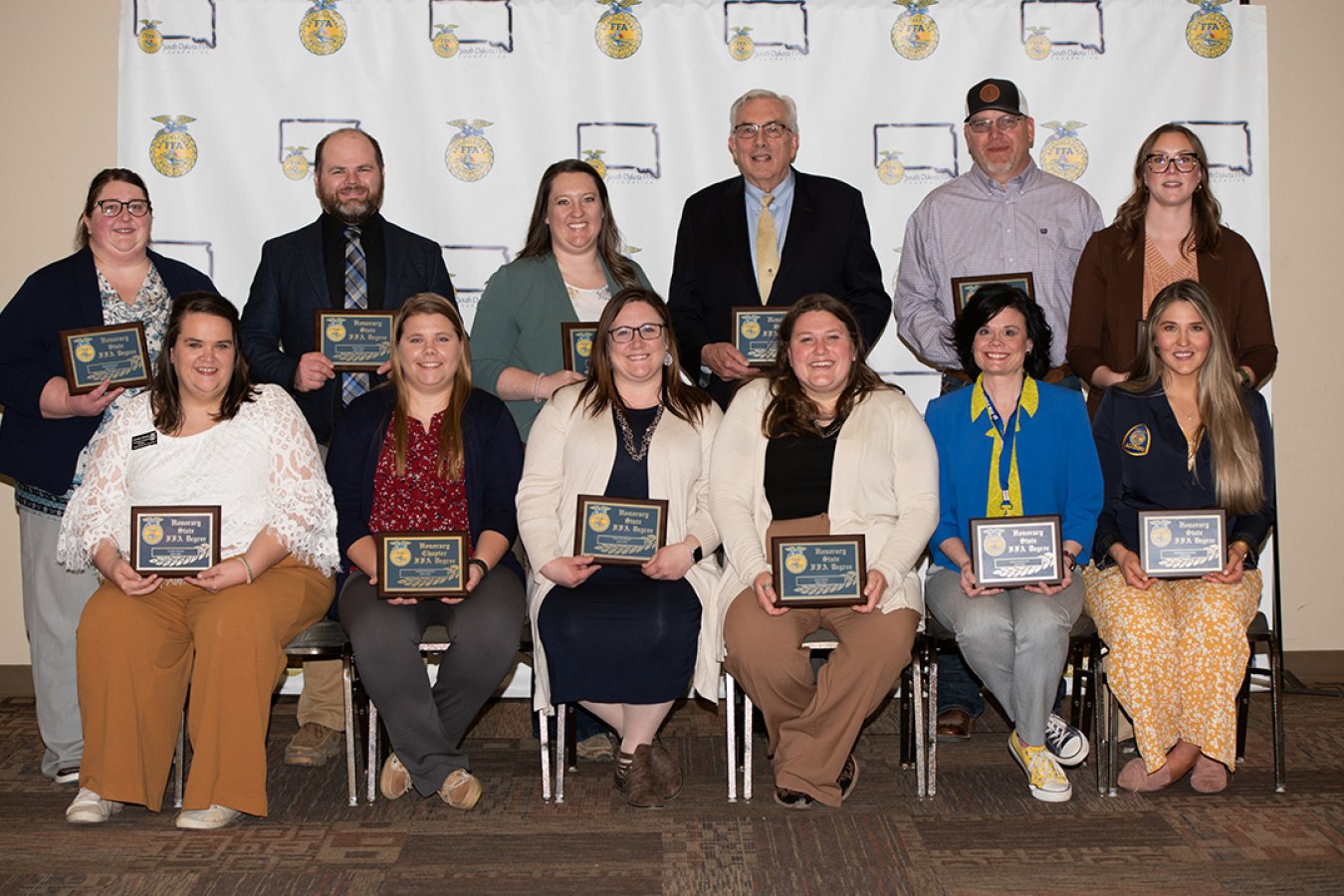05/09/2024 SOURCE: www.sdstate.edu
South Dakota State University leaders and faculty were among the honorees as the South Dakota FFA Honorary State Degrees and Distinguished Service Awards were presented at the 96th annual South Dakota State FFA Convention on April 19 in Brookings. These awards recognize outstanding contributions in support of the South Dakota FFA, acknowledging that ag leaders and industry are key in developing future agriculture and community leaders.
SDSU President Barry Dunn received an Honorary State FFA Degree. The Honorary State FFA Degree recognizes individuals who are helping to advance agricultural education and the FFA organization and who have rendered outstanding service to the organization with their time, talents and treasures. Distinguished Service Award recipients from SDSU were, back from left: representing the SDSU Meat Lab, Adam Rhody, SDSU Meat Lab manager; Rosie Nold, assistant department head and professor in the Department of Animal Science; Christina Bakker, assistant professor and SDSU Extension meat science specialist; and John Jaeger, head of the Department of Animal Science and professor. Front from left: Howard Bonnemann, lecturer in the Department of Dairy and Food Science; Joe and Nicole Klein, associate academic director and professor in the Ness School of Management and Economics; and Lon Moeller, professor of agricultural education emeritus. Not pictured is Mary Moeller, retired associate professor from the College of Education and Human Sciences. The 2024 Distinguished Service Award recipients from SDSU are: Howard Bonneman, lecturer in the Department of Dairy and Food Science SDSU Meat Lab Joe and Nicole Klein, associate academic director and professor in the Ness School of Management and Economics Lon and Mary Moeller, professor of agricultural education emeritus and retired associate professor in the College of Education and Human Sciences The Distinguished Service Award is presented to individuals and businesses who have taken action to advocate for agriculture education on the ...
SDSU reps recognized with FFA honorary degrees, distinguished service awards
-
(0)
-
Bookmark
- Comments (0)
 John LaRose Jr.
John LaRose Jr.
Topics: Soybeans, Livestock/Meat, Agriculture Global, Education U.S. MidWest, Animal Health,
Compounds from soybeans may improve animal health
Antimicrobial compounds that soybean plants produce when threatened by insects, diseases and even drought may help animals stay healthy, thereby reducing the need for antibiotics. “When a soybean is attacked by a pathogen, the plant produces phytochemicals called glyceollins as a defense mechanism,” explained assistant professor Bishnu Karki of South Dakota State University’s Department of Biology and Microbiology. Her research group has identified pathogens and lab-scale processes to trigger production of glyceollins and begun assessing soybean varieties to see which produce higher levels of the antimicrobial compounds. “Animals, such as pigs and poultry, already consume diets high in soybeans and could benefit from the phytochemical’s antimicrobial properties,” Karki said, pointing out scientists are studying the impact of glyceollins on human health, specifically in relation to cancer, inflammation and cardiovascular diseases. Karki’s research is supported by U.S. Department of Agriculture Hatch Act funding through the South Dakota Agricultural Experiment Station. Two master’s students and several undergraduates have also worked on the project. In the past, antibiotics were integrated into animal feed and water to help animals stay healthy and reach market weight efficiently. However, the FDA’s Veterinary Feed Directive, which seeks to decrease the development of antibiotic-resistance microorganisms, recently limited the use of antibiotics to specific health problems. Therefore, livestock producers are in need of natural alternatives, such as glyceollin-enriched soybeans, that can provide benefits similar to those of antibiotics. Doctoral candidate Ahmad Alhomodi, left, and assistant professor Bishnu Karki of the Department of Biology and Microbiology examine soybeans inoculated with two different edible fungi. The pathogens stress the beans so they produce glyceollins, which have antimicrobial properties.Producing glyceollins Under normal conditions, glyceollins are not present...
-
(0)
-
Bookmark
- Comments (0)
 John LaRose Jr.
John LaRose Jr.
Topics: Soil Health, Precision AG , Agriculture US, Cover Crops, Crop Consultant, Agriculture Global, Water, Sustainability, Education,
South Dakota producers reap rewards of cover crops
The longer farmers use cover crops, the more likely they are to see the benefits and to use the conservation practice on a higher percentage of their farmland, according to a survey of eastern South Dakota producers. Cover crops, which are planted after harvesting the cash crop, help prevent erosion and runoff and increase soil organic matter, thereby reducing the need for fertilizer and improving water quality. In addition, cover crops can help suppress weeds, thereby reducing herbicide and pesticide usage, according to assistant professor Tong Wang of South Dakota State University’s Ness School of Management and Economics. She is part of a team of SDSU researchers who conducted the spring 2018 survey to evaluate producers’ perceptions about the benefits of conservation practices aimed at improving soil health, reducing the industry’s carbon footprint and increasing the sustainability of agriculture. Furthermore, Wang reported those who use cover crops for grazing are more likely to view them as increasing their profitability, even during the first few years. “Grazing helps offset the cost of using cover crops by reducing forage costs.” More than 70% of South Dakota producers graze their livestock on crop residue and cover crops, according to a 2016 survey in the Northern Great Plains. An article on South Dakota farmers’ perceptions about profitability and their likelihood of continuing to use cover crops was published in the Journal of Agricultural and Resource Economics. The research was funded by the South Dakota Corn Utilization Council and the U.S. Department of Agriculture Natural Resources Conservation Service. Tracking cover crop usage In the contiguous United States, the number of acres on which farmers plant cover crops increased from 218,000 in 2012 to 619,000 in 2017, according to the fifth-annual Sustainable Agriculture Research and Education–Conservation Technology Information Center cover-crop survey. Of the 708 South Dakota producers who responded to the SDSU researchers’ su...
-
(1)
-
Bookmark
- Comments (0)





